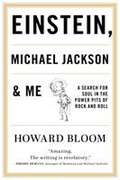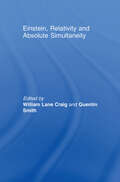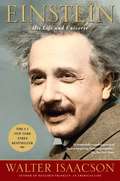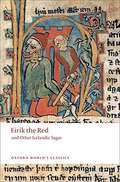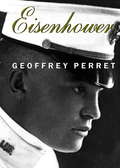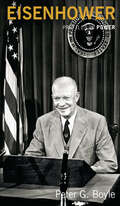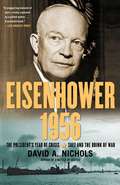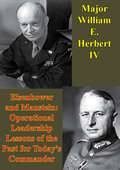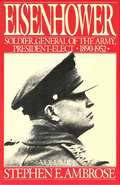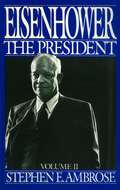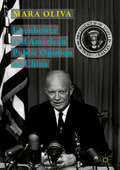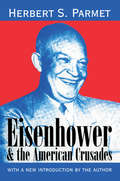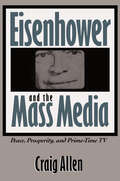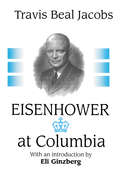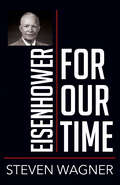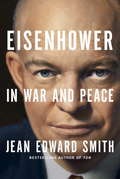- Table View
- List View
Einstein's War: How Relativity Triumphed Amid the Vicious Nationalism of World War I
by Matthew StanleyKIRKUS STARRED REVIEWPUBLISHER'S WEEKLY STARRED REVIEWThe birth of a world-changing idea in the middle of a bloodbath Einstein’s War is a riveting exploration of both the beauty of scientific creativity and enduring horrors of human nature. These two great forces battle in a story that culminates with a victory now a century old, the mind bending theory of general relativity. Few recognize how the Great War, the industrialized slaughter that bled Europe from 1914 to 1918, shaped Einstein’s life and work. While Einstein never held a rifle, he formulated general relativity blockaded in Berlin, literally starving. He lost 50 pounds in three months, unable to communicate with his most important colleagues. Some of those colleagues fought against rabid nationalism; others were busy inventing chemical warfare—being a scientist trapped you in the power plays of empire. Meanwhile, Einstein struggled to craft relativity and persuade the world that it was correct. This was, after all, the first complete revision of our conception of the universe since Isaac Newton, and its victory was far from sure. Scientists seeking to confirm Einstein’s ideas were arrested as spies. Technical journals were banned as enemy propaganda. Colleagues died in the trenches. Einstein was separated from his most crucial ally by barbed wire and U-boats. This ally was the Quaker astronomer and Cambridge don A.S. Eddington who would go on to convince the world of the truth of relativity and the greatness of Einstein. In May of 1919, when Europe was still in chaos from the war, Eddington led a globe-spanning expedition to catch a fleeting solar eclipse for a rare opportunity to confirm Einstein’s bold prediction that light has weight. It was the result of this expedition—the proof of relativity, as many saw it—that put Einstein on front pages around the world. Matthew Stanley’s epic tale is a celebration of how bigotry and nationalism can be defeated, and of what science can offer when they are.
Einstein's Wife: The Real Story of Mileva Einstein-Mari? (The\mit Press Ser.)
by David C. Cassidy Allen EstersonWas Einstein's first wife his uncredited coauthor, unpaid assistant, or his unacknowledged helpmeet? The real “Mileva Story.”Albert Einstein's first wife, Mileva Einstein-Marić, was forgotten for decades. When a trove of correspondence between them beginning in their student days was discovered in 1986, her story began to be told. Some of the tellers of the “Mileva Story” made startling claims: that she was a brilliant mathematician who surpassed her husband, and that she made uncredited contributions to his most celebrated papers in 1905, including his paper on special relativity. This book, based on extensive historical research, uncovers the real “Mileva Story.” Mileva was one of the few women of her era to pursue higher education in science; she and Einstein were students together at the Zurich Polytechnic. Mileva's ambitions for a science career, however, suffered a series of setbacks—failed diploma examinations, a disagreement with her doctoral dissertation adviser, an out-of-wedlock pregnancy by Einstein. She and Einstein married in 1903 and had two sons, but the marriage failed. Was Mileva her husband's uncredited coauthor, unpaid assistant, or his essential helpmeet? It's tempting to believe that she was her husband's secret collaborator, but the authors of Einstein's Wife look at the actual evidence, and a chapter by Ruth Lewin Sime offers important historical context. The story they tell is that of a brave and determined young woman who struggled against a variety of obstacles at a time when science was not very welcoming to women.
Einstein, Michael Jackson and Me: A Search for Soul in the Power Pits of rock and Roll
by Howard BloomHoward Bloom--called "the greatest press agent that rock and roll has ever known" by Derek Sutton, the former manager of Styx, Ten Years After, and Jethro Tull--is a science nerd who knew nothing about popular music. But he founded the biggest PR firm in the music industry and helped build or sustain the careers of our biggest rock-and-roll legends, including Michael Jackson, Prince, Bob Marley, Bette Midler, Billy Joel, Billy Idol, Paul Simon, Peter Gabriel, David Byrne, AC/DC, Aerosmith, Queen, Kiss, Grandmaster Flash and the Furious Five, Run DMC, ZZ Top, Joan Jett, Chaka Khan, and one hundred more. What was he after? He was on a hunt for the gods inside of you and me. Einstein, Michael Jackson & Me is Bloom's story--the strange tale of a scientific expedition into the dark underbelly of science and fame where new myths and movements are made. Based in Park Slope, Brooklyn, HOWARD BLOOM, also an extensive writer in the field of science, has been called "next in a lineage of seminal thinkers that includes Newton, Darwin, Einstein, [and] Freud" by Britain's Channel 4 TV, and "the next Stephen Hawking" by Gear magazine. One of Bloom's seven books, Global Brain, was the subject of an Office of the Secretary of Defense symposium with participants from the State Department, the Energy Department, DARPA, IBM, and MIT. Among other things, his insights into Michael Jackson may surprise you.
Einstein, Relativity and Absolute Simultaneity (Routledge Studies in Contemporary Philosophy)
by William Lane Craig Quentin SmithEinstein, Relativity and Absolute Simultaneity is an anthology of original essays by an international team of leading philosophers and physicists who have come together to reassess the contemporary paradigm of the relativistic concept of time. A great deal has changed since 1905 when Einstein proposed his Special Theory of Relativity, and this book offers a fresh reassessment of Special Relativity’s relativistic concept of time in terms of epistemology, metaphysics, and physics.
Einstein: His Life and Universe (Great Thinkers Ser.)
by Walter IsaacsonBy the author of the acclaimed bestsellers Benjamin Franklin and Steve Jobs, this is the definitive biography of Albert Einstein. How did his mind work? What made him a genius? Isaacson’s biography shows how his scientific imagination sprang from the rebellious nature of his personality. His fascinating story is a testament to the connection between creativity and freedom. Based on newly released personal letters of Einstein, this book explores how an imaginative, impertinent patent clerk—a struggling father in a difficult marriage who couldn’t get a teaching job or a doctorate—became the mind reader of the creator of the cosmos, the locksmith of the mysteries of the atom, and the universe. His success came from questioning conventional wisdom and marveling at mysteries that struck others as mundane. This led him to embrace a morality and politics based on respect for free minds, free spirits, and free individuals. These traits are just as vital for this new century of globalization, in which our success will depend on our creativity, as they were for the beginning of the last century, when Einstein helped usher in the modern age.
Eirik The Red And Other Icelandic Sagas (World's Classics)
by Gwyn JonesSelected by Gwyn Jones--the eminent Celtic scholar--for their excellence and variety, these nine Icelandic sagas include "Hen-Thorir," "The Vapnfjord Men," "Thorstein Staff-Struck," "Hrafnkel the Priest of Frey," "Thidrandi whom the Goddesses Slew," "Authun and the Bear," "Gunnlaug Wormtongue," "King Hrolf and his Champions," and the title piece.
Eisenhower
by Geoffrey PerretDrawing on newly available material, including Eisenhower's papers and diaries, author and military historian Geoffrey Perret offers a comprehensive portrait of the life, military exploits, political life, and presidency of Dwight D. Eisenhower (1890-1969). He covers several controversies including an alleged dalliance, Eisenhower's break with MacArthur in 1939, his opinion of Nixon, and his role in McCarthy's activities. Annotation c. Book News, Inc., Portland, OR (booknews.com)
Eisenhower
by Jim Newton"Newton's contribution is as cogent an inventory of Eisenhower's White House years as I've ever read. He blends masterful writing with historic detail and provides the value-added of Ike as the man and the leader."--Chuck Hagel, Distinguished Professor, Georgetown University; U.S. Senator (1997-2009)Newly discovered and declassified documents make for a surprising and revealing portrait of the president we thought we knew.America's thirty-fourth president was belittled by his critics as the babysitter-in-chief. This new look reveals how wrong they were. Dwight Eisenhower was bequeathed the atomic bomb and refused to use it. He ground down Joseph McCarthy and McCarthyism until both became, as he said, "McCarthywasm." He stimulated the economy to lift it from recession, built an interstate highway system, turned an $8 billion deficit in 1953 into a $500 million surplus in 1960. (Ike was the last President until Bill Clinton to leave his country in the black.) The President Eisenhower of popular imagination is a benign figure, armed with a putter, a winning smile, and little else. The Eisenhower of veteran journalist Jim Newton's rendering is shrewd, sentimental, and tempestuous. He mourned the death of his first son and doted on his grandchildren but could, one aide recalled, "peel the varnish off a desk" with his temper. Mocked as shallow and inarticulate, he was in fact a meticulous manager. Admired as a general, he was a champion of peace. In Korea and Vietnam, in Quemoy and Berlin, his generals urged him to wage nuclear war. Time and again he considered the idea and rejected it. And it was Eisenhower who appointed the liberal justices Earl Warren and William Brennan and who then called in the military to enforce desegregation in the schools.Rare interviews, newly discovered records, and fresh insights undergird this gripping and timely narrative.JIM NEWTON is a veteran journalist who began his career as clerk to James Reston at the New York Times. Since then, he has worked as a reporter at the Atlanta Constitution and as a reporter, bureau chief and editor at the Los Angeles Times, where he presently is the editor-at-large and author of a weekly column. He also is an educator and author, whose acclaimed biography of Chief Justice Earl Warren, Justice for All: Earl Warren and the Nation He Made, was published in 2006. He lives in Pasadena, CA.From the Hardcover edition.
Eisenhower
by Paul JohnsonAcclaimed historian Paul Johnson's lively, succinct biography of Dwight D. Eisenhower explores how his legacy endures today In the rousing style he's famous for, celebrated biographer Paul Johnson offers a fascinating portrait of Dwight D. Eisenhower, focusing particularly on his years as a five-star general and his time as the thirty-fourth President of the United States. Johnson chronicles President Eisenhower's modest childhood in Kansas, his college years at West Point, and his rapid ascent through the military ranks, culminating in his appointment as Supreme Commander of the Allied Forces in Europe during World War II. Beginning when Eisenhower assumed the presidency from Harry Truman in 1952, Johnson paints a rich portrait of his two consecutive terms, exploring his volatile relationship with then-Vice President Richard Nixon, his abhorrence of isolationism, and his position on the Cold War, McCarthyism, and the Civil Rights Movement. Johnson notes that when Eisenhower left the White House at age 70, reluctantly passing the torch to President-elect John F. Kennedy, he feared for the country's future and prophetically warned of the looming military-industrial complex. Many elements of Eisenhower's presidency speak to American politics today, including his ability to balance the budget and skill in managing an oppositional Congress. This brief yet comprehensive study will appeal to biography lovers as well as to enthusiasts of presidential history and military history alike.
Eisenhower
by Paul JohnsonAcclaimed historian Paul Johnson's lively, succinct biography of Dwight D. Eisenhower explores how his legacy endures today In the rousing style he's famous for, celebrated biographer Paul Johnson offers a fascinating portrait of Dwight D. Eisenhower, focusing particularly on his years as a five-star general and his time as the thirty-fourth President of the United States.Johnson chronicles President Eisenhower's modest childhood in Kansas, his college years at West Point, and his rapid ascent through the military ranks, culminating in his appointment as Supreme Commander of the Allied Forces in Europe during World War II. Beginning when Eisenhower assumed the presidency from Harry Truman in 1952, Johnson paints a rich portrait of his two consecutive terms, exploring his volatile relationship with then-Vice President Richard Nixon, his abhorrence of isolationism, and his position on the Cold War, McCarthyism, and the Civil Rights Movement. Johnson notes that when Eisenhower left the White House at age 70, reluctantly passing the torch to President-elect John F. Kennedy, he feared for the country's future and prophetically warned of the looming military-industrial complex.Many elements of Eisenhower's presidency speak to American politics today, including his ability to balance the budget and skill in managing an oppositional Congress. This brief yet comprehensive study will appeal to biography lovers as well as to enthusiasts of presidential history and military history alike.
Eisenhower
by Steven Zaloga Steve NoonDwight Eisenhower represented a fundamentally new type of military commander in the 20th century: commander as manager rather than the traditional warrior commander. Armies had become so large and military coalitions so dependent on politics that this new type of commander emerged. Eisenhower never fought in a single battle, but he commanded the most modern and powerfully armed force to fight in Europe. As Supreme Commander of the Allied Expeditionary Force, Eisenhower had at his disposal not only the British, US, and French armies, but the RAF, USAAF, Royal Navy and US Navy-Atlantic. This book explores every aspect of his military career.From the Trade Paperback edition.
Eisenhower & Cambodia: Diplomacy, Covert Action, and the Origins of the Second Indochina War (Studies In Conflict, Diplomacy, And Peace Ser.)
by William J. RustThis historical study examines America’s Cold War diplomacy and covert operations intended to lure Cambodia from neutrality to alliance.Although most Americans paid little attention to Cambodia during Dwight D. Eisenhower’s presidency, the global ideological struggle with the Soviet Union guaranteed US vigilance throughout Southeast Asia. Cambodia’s leader, Norodom Sihanouk, refused to take sides in the Cold War, a policy that disturbed US officials. From 1953 to 1961, his government avoided the political and military crises of neighboring Laos and South Vietnam. However, relations between Cambodia and the United States suffered a blow in 1959 when Sihanouk discovered CIA involvement in a plot to overthrow him. The failed coup only increased Sihanouk’s power and prestige, presenting new foreign policy challenges in the region.In Eisenhower and Cambodia, William J. Rust demonstrates that covert intervention in the political affairs of Cambodia proved to be a counterproductive tactic for advancing the United States’ anticommunist goals. Drawing on recently declassified sources, Rust skillfully traces the impact of “plausible deniability” on the formulation and execution of foreign policy. His meticulous study not only reveals a neglected chapter in Cold War history but also illuminates the intellectual and political origins of US strategy in Vietnam and the often-hidden influence of intelligence operations in foreign affairs.
Eisenhower (Profiles In Power)
by P G. BoyleEisenhower is the president who established America as a superpower. He had already launched his reputation as the leading US military figure in the Second World War and then as supreme commander of the land forces of the newly created NATO. This book looks at how Eisenhower held power in the political field, and to what extent his political career was a success. This text is ideal for undergraduate courses in 20th Century American History and American Studies.
Eisenhower 1956
by David. A. NicholsA gripping tale of international intrigue and betray-al, Eisenhower 1956 is the white-knuckle story of how President Dwight D. Eisenhower guided the United States through the Suez Canal crisis of 1956. The crisis climaxed in a tumultuous nine-day period fraught with peril just prior to the 1956 presidential election, with Great Britain, France, and Israel invading Egypt while the Soviet Union ruthlessly crushed rebellion in Hungary. David A. Nichols, a leading expert on Eisenhower's presidency, draws on hundreds of documents declassified in the last thirty years, enabling the reader to look over Ike's shoulder and follow him day by day, sometimes hour by hour as he grappled with the greatest international crisis of his presidency. The author uses formerly top secret minutes of National Security Council and Oval Office meetings to illuminate a crisis that threatened to escalate into global conflict. Nichols shows how two life-threatening illnesses--Eisenhower's heart attack in September 1955 and his abdominal surgery in June 1956--took the president out of action at critical moments and contributed to missteps by his administration. In 1956, more than two thirds of Western Europe's oil supplies transited the Suez Canal, which was run by a company controlled by the British and French, Egypt's former colonial masters. When the United States withdrew its offer to finance the Aswan Dam in July of that year, Egypt's president, Gamal Abdel Nasser, nationalized the canal. Without Eisenhower's knowledge, Britain and France secretly plotted with Israel to invade Egypt and topple Nasser. On October 29--nine days before the U.S. presidential election--Israel invaded Egypt, setting the stage for a "perfect storm." British and French forces soon began bombing Egyptian ports and airfields and landing troops who quickly routed the Egyptian army. Eisenhower condemned the attacks and pressed for a cease-fire at the United Nations. Within days, in Hungary, Soviet troops and tanks were killing thousands to suppress that nation's bid for freedom. When Moscow openly threatened to intervene in the Middle East, Eisenhower placed American military forces--including some with nuclear weapons--on alert and sternly warned the Soviet Union against intervention. On November 6, Election Day, after voting at his home in Gettysburg, Ike rushed back to the White House to review disturbing intelligence from Moscow with his military advisors. That same day, he learned that the United Nations had negotiated a cease-fire in the Suez war--a result, in no small measure, of Eisenhower's steadfast opposition to the war and his refusal to aid the allies. In the aftermath of the Suez crisis, the United States effectively replaced Great Britain as the guarantor of stability in the Middle East. More than a half century later, that commitment remains the underlying premise for American policy in the region. Historians have long treated the Suez Crisis as a minor episode in the dissolution of colonial rule after World War II. As David Nichols makes clear in Eisenhower 1956, it was much more than that.
Eisenhower And Manstein: Operational Leadership Lessons Of The Past For Today's Commanders
by Major William E. Herbert IVThe United States Military, the ultimate Instrument of national resolve, is centered on servicemen and women. Without effective leadership these men and women are ill equipped to succeed in combat and are unjustly put in harm's way. The commander at the operational level is the link between national policy and action. His actions, character and decisions are of historical importance. While this paper will not cover the full spectrum of operational leadership; the most important traits of operational leadership will be explored. Additionally, this paper will highlight recent failures in operational leadership and compare and contrast them with lessons learned from two diametrically opposed operational leaders of World War II, General Dwight Eisenhower and Field Marshall Erich von Manstein. Analysis will concentrate on the specific operations of the Normandy invasion and Kharkov. The analysis will not deconstruct the operations but rather center on the operational leadership traits each commander displayed and their importance to the operation. Finally the paper will show how the lessons of sixty-five years ago are applicable today and for the future.
Eisenhower Volume I: Soldier, General of the Army, President-Elect, 1890-1952
by Stephen E. AmbroseDwight Eisenhower was not exactly born into poverty, but the family's circumstances were at least austere. He was one of seven children; his father, a railway worker. But the family was strong and unified, the youngsters energetic and ambitious.<P> Ike made it to West Point, where he excelled in sports. He was a natural leader. But it was at Leavenworth years later, as a student at the war college, that his intellectual talent showed itself. He graduated first in his class.<P> The author draws in a wealth of previously unpublished information to give us this beautiful portrait. As a result Eisenhower emerges as complex, one who as the author states, ". . .was a good and great man."
Eisenhower Volume II: The President
by Stephen E. AmbroseEisenhower: The President, the second and concluding volume of Stephen Ambrose's brilliant biography, is the first assessment of a postwar President based on access to the entire record. It covers a wide range of subjects, including Eisenhower's rejection of the near-unanimous advice he received as President to use atomic weapons; his thinking on defense policy and the Cold War; his handling of a multitude of foreign-affairs crises; his attitudes and actions on civil rights; his views on Joseph McCarthy and on communism. Also illuminated are Eisenhower's relations with Nixon, Truman, Khrushchev, de Gaulle, and other world leaders. Ambrose provides us with an extraordinary portrait -- fairminded and enormously well-informed -- of the man, both decent and complex, who is increasingly regarded as one of the twentieth century's greatest Presidents.
Eisenhower and American Public Opinion on China
by Mara OlivaIn the 1950s, most of the American public opposed diplomatic and trade relations with Communist China; traditional historiography blames this widespread hostility for the tensions between China and the United States during Dwight D. Eisenhower’s presidency. In this book, Mara Oliva reconsiders the influence of U.S. public opinion on Sino-American relations, arguing that it is understudied and often misinterpreted. She shows how the Eisenhower administration’s hard line policy towards Beijing had been formulated in line with U.S. national security interests, not as a result of public pressure. However, the public did play a significant role in shaping the implementation, timing and political communication of Washington’s strategy, ultimately hampering relations with the Communist giant and seriously heightening the risk of nuclear conflict. Drawing together an extensive array of published and unpublished sources, this book offers a new prism for understanding one of the most difficult decades in the history of both countries.
Eisenhower and the American Crusades
by Herbert S. ParmetHerbert S. Parmet's Eisenhower and the American Crusades is a major assessment of the American presidency during the critical period of America at mid-century. The book follows the career of General Dwight D. Eisenhower from 1952, when he decided to leave his NATO command to campaign for the presidency, to his retirement at Gettysburg nearly nine years later. His entry into politics was well-timed. A mood of conservatism was sweeping the country; surveys indicated that the majority of Americans felt it was time for a change from two decades of executive control 'by those who had permitted events to get out of hand.'Parmet based his study of the Eisenhower years on massive research, conversations with leading figures of the era, and previously unreleased documents. This wealth of material has enabled him to provide answers to questions frequently asked about the thirty-fourth president: Was Eisenhower the kind, fatherly man millions grew up to love on their television or was this an image created by a shrewd politician who knew what the country needed in a trying time?Did he choose Richard Nixon as a running mate or was Nixon forced upon him by political necessities? Was the president intimidated by the appearance of power of Joseph McCarthy, and did the Army-McCarthy hearings influence Eisenhower's decision to involve the United States in Vietnam? Was Eisenhower concerned with the lack of progress in civil rights? Was he the right man for the right time in history or was he merely postponing the major crises of the 1960s?Parmet offers a convincing refutation of the idea of the Eisenhower years as being placid or boring. 'No years that contained McCarthy and McCarthyism, a war in Korea, constant fears of nuclear annihilation, and spreading racial violence, could be so described.' For Parmet, Eisenhower was a stabilizing force in a time of conflict. He may not have been a political genius, but he knew perhaps better than anyone else around him exactly what the people wanted and how they wanted it.
Eisenhower and the Cold War Economy
by William M. McClenahan Jr. William H. BeckerThroughout his two-term presidency, Dwight D. Eisenhower faced the challenge of managing a period of peacetime prosperity after more than two decades of depression, war, and postwar inflation. The essential issue he addressed was how the country would pay for the deepening Cold War and the extent to which such unprecedented peacetime commitments would affect the United States economy and its institutions. William M. McClenahan, Jr., and William H. Becker explain how Eisenhower’s beliefs and his experiences as a military bureaucrat and wartime and postwar commander shaped his economic policies. They explore the macro- and microeconomic policies his administration employed to finance the Cold War while adapting Republican ideas and Eisenhower's economic principles to new domestic and foreign policy environments. They also detail how Eisenhower worked with new instruments of government policy making, such as the Council of Economic Advisers and a strengthened Federal Reserve Board. In assessing his administration's policies, the authors demonstrate that, rather than focusing overwhelmingly on international political affairs at the expense of economic issues, Eisenhower’s policies aimed to preserve and enhance the performance of the American free market system, which he believed was inextricably linked to the successful prosecution of the Cold War. While some of the decisions Eisenhower made did not follow conservative doctrine as closely as many in the Republican Party wanted, this book asserts that his approach to and distrust of partisan politics led to success on many fronts and indeed maintained and buttressed the nation's domestic and international economic health. An important and original contribution, this examination of the Eisenhower administration's economic policy enriches our understanding of the history of the modern American economy, the presidency, and conservatism in the United States.
Eisenhower and the Mass Media: Peace, Prosperity, and Prime-time TV
by Craig AllenA UNC Press Enduring Edition -- UNC Press Enduring Editions use the latest in digital technology to make available again books from our distinguished backlist that were previously out of print. These editions are published unaltered from the original, and are presented in affordable paperback formats, bringing readers both historical and cultural value.
Eisenhower at Columbia
by Travis JacobsFirst Published in 2018. Routledge is an imprint of Taylor & Francis, an Informa company.
Eisenhower for Our Time (People for Our Time)
by Steven WagnerEisenhower for Our Time provides an introduction to the Eisenhower presidency, extracting lessons for today's world. Steven Wagner proposes that the need to maintain balance defines Eisenhower's presidency. Wagner examines a series of defining moments that were among Eisenhower's greatest challenges, some of which resulted in his greatest accomplishments: the decision to run for president, his political philosophy of the "Middle Way," the creation of a national security policy, the French Indochina War, Senator Joseph McCarthy, the Little Rock Desegregation Crisis, the Race for Space, and the famous Farewell Address. Wagner looks at Eisenhower's executive ability, leadership, decision making, and willingness to compromise, as well as the qualities of duty, integrity, and good character. The moments detailed in Eisenhower for Our Time show Eisenhower as a president intimately engaged in the decisions that defined America in his time and that apply to ours today. The President's actions place him among the most successful presidents and provide many lessons to guide us in our time and in the future.
Eisenhower in War and Peace
by Jean Edward SmithIn his magisterial bestseller FDR, Jean Edward Smith gave us a fresh, modern look at one of the most indelible figures in American history. Now this peerless biographer returns with a new life of Dwight D. Eisenhower that is as full, rich, and revealing as anything ever written about America's thirty-fourth president. As America searches for new heroes to lead it out of its present-day predicaments, Jean Edward Smith's achievement lies in reintroducing us to a hero from the past whose virtues have become clouded in the mists of history. Here is Eisenhower the young dreamer, charting a course from Abilene, Kansas, to West Point, to Paris under Pershing, and beyond. Drawing on a wealth of untapped primary sources, Smith provides new insight into Ike's maddening apprenticeship under Douglas MacArthur in Washington and the Philippines. Then the whole panorama of World War II unfolds, with Eisenhower's superlative generalship forging the Allied path to victory through multiple reversals of fortune in North Africa and Italy, culminating in the triumphant invasion of Normandy. Smith also gives us an intriguing examination of Ike's finances, details his wartime affair with Kay Summersby, and reveals the inside story of the 1952 Republican convention that catapulted him to the White House.Smith's chronicle of Eisenhower's presidential years is as compelling as it is comprehensive. Derided by his detractors as a somnambulant caretaker, Eisenhower emerges in Smith's perceptive retelling as both a canny politician and a skillful, decisive leader. Smith convincingly portrays an Eisenhower who engineered an end to America's three-year no-win war in Korea, resisted calls for preventative wars against the Soviet Union and China, and boldly deployed the Seventh Fleet to protect Formosa from invasion. This Eisenhower, Smith shows us, stared down Khrushchev over Berlin and forced the withdrawal of British, French, and Israeli forces from the Suez Canal. He managed not only to keep the peace--after Ike made peace in Korea, not one American soldier was killed in action during his tenure--but also to enhance America's prestige in the Middle East and throughout the world.Domestically, Eisenhower reduced defense spending, balanced the budget, constructed the interstate highway system, and provided social security coverage for millions who were self-employed. Ike believed that traditional American values encompassed change and progress.Unmatched in insight, Eisenhower in War and Peace at last gives us an Eisenhower for our time--and for the ages.From the Hardcover edition.
Eisenhower on the War: The Complete Report By The Supreme Commander On The War In Europe
by Dwight D. EisenhowerFirst published in 1946 as Eisenhower’s Own Story of the WarTHIS is one of the truly great documents in the history of human conflict. It is the personal, yet definitive report of the world’s mightiest military operation, written by the one man qualified to write it, the man under whose Supreme Command the Allied forces rode to triumph. A classic of information, in the plain language for which our Chief of Staff is famous, it reveals the whole inside story of how the war was run and won.


